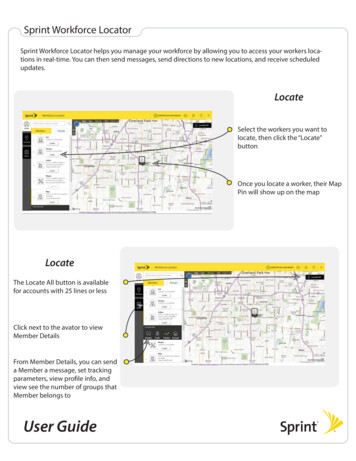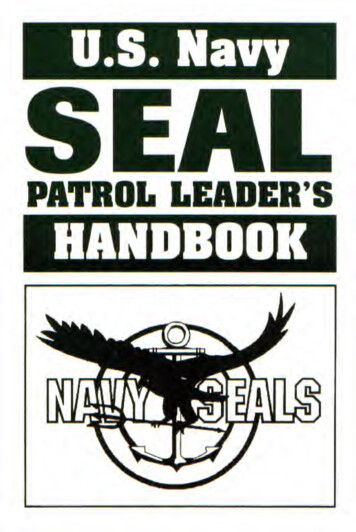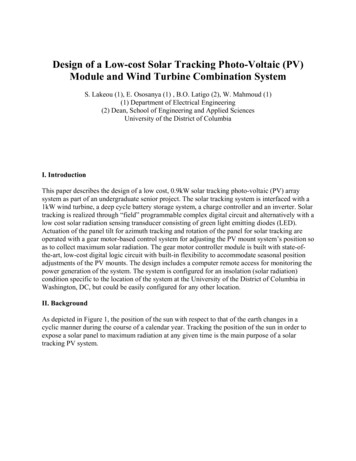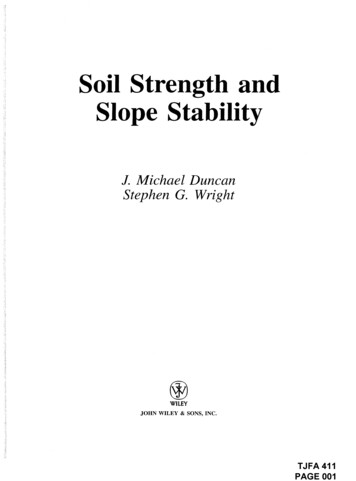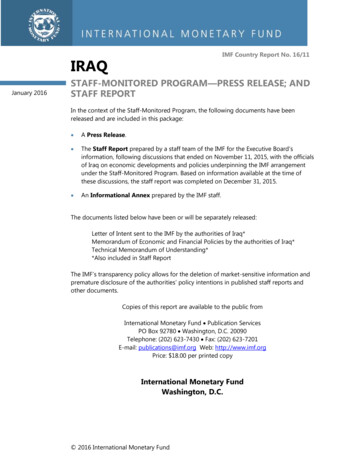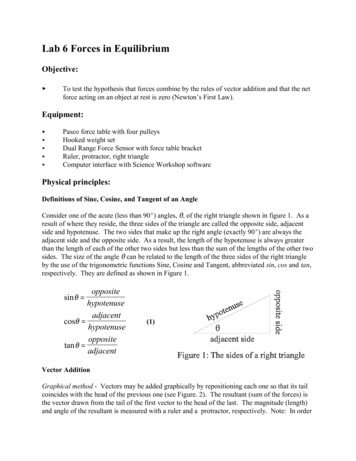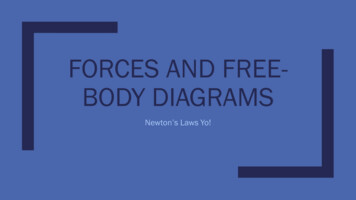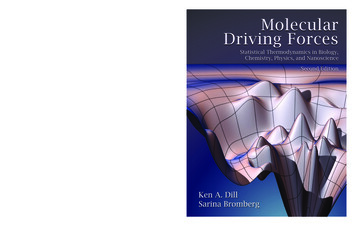Transcription
TC 31-34-4Special ForcesTracking and CountertrackingSeptember 2009DISTRIBUTION RESTRICTION: Distribution authorized to U.S. Government agencies and their contractors onlyto protect technical or operational information from automatic dissemination under the International ExchangeProgram or by other means. This determination was made on 15 June 2009. Other requests for this documentmust be referred to Commander, United States Army John F. Kennedy Special Warfare Center and School,ATTN: AOJK-DTD-SF, Fort Bragg, NC 28310-9610.DESTRUCTION NOTICE: Destroy by any method that will prevent disclosure of contents or reconstruction of thedocument.FOREIGN DISCLOSURE RESTRICTION (FD 6): This publication has been reviewed by the product developersin coordination with the United States Army John F. Kennedy Special Warfare Center and School foreigndisclosure authority. This product is releasable to students from foreign countries on a case-by-case basis only.Headquarters, Department of the Army
TC 31-34-4HeadquartersDepartment of the ArmyWashington, DC, 30 September 2009Training Circular31-34-4Special ForcesTracking and CountertrackingContentsPagePREFACE . ivChapter 1TRACKING . 1-1Introduction . 1-1Tracking Signs . 1-2Tracking Indicators . 1-2Chapter 2COUNTERTRACKING . 2-1Introduction . 2-1Camouflage . 2-1Chapter 3DOG-TRACKER TEAMS . 3-1Introduction . 3-1Techniques to Defeat Dog-Tracker Teams . 3-4Appendix ATRACKING LOG . A-1Appendix BTRACKING LOG FOR TRAINING PURPOSES . B-1GLOSSARY . Glossary-1REFERENCES . References-1INDEX . Index-1Distribution Restriction: Distribution authorized to U.S. Government agencies and their contractors only toprotect technical or operational information from automatic dissemination under the International ExchangeProgram or by other means. This determination was made on 15 July 2009. Other requests for this documentmust be referred to Commander, United States Army John F. Kennedy Special Warfare Center and School,ATTN: AOJK-DTD-SF, Fort Bragg, NC 28310-9610.Destruction Notice: Destroy by any method that will prevent disclosure of contents or reconstruction of thedocument.Foreign Disclosure Restriction (FD 6): This publication has been reviewed by the product developers incoordination with the United States Army John F. Kennedy Special Warfare Center and School foreign disclosureauthority. This product is releasable to students from foreign countries on a case-by-case basis only.i
ContentsFiguresFigure 1-1. Area a tracker surveys to find tracking indicators . 1-2Figure 1-2. Footprint in soft, moist ground conditions . 1-3Figure 1-3. Print made by “box edge,” indicating equipment (rifle stock) . 1-3Figure 1-4. Crushed vegetation with toe scuffs, indicate a person had taken a proneposture (feet to the upper right, head to the lower left) . 1-4Figure 1-5. Footprints left by someone running . 1-4Figure 1-6. Footprints left by someone carrying a heavy load. 1-5Figure 1-7. Footprints left by someone walking backward in dry sand. 1-5Figure 1-8. Footprints left by someone walking backward in wet sand . 1-6Figure 1-9. Footprints left by someone walking backward over vegetation. 1-6Figure 1-10. Man versus woman . 1-7Figure 1-11. Using the stride as a unit of measure . 1-8Figure 1-12. Using the 36-inch box method. 1-8Figure 1-13. Broken dirt seal around rocks indicating disturbance . 1-9Figure 1-14. Turned over rocks and sticks . 1-9Figure 1-15. Crushed or disturbed vegetation on a creek bank . 1-10Figure 1-16. Crushed or disturbed vegetation “high sign” . 1-10Figure 1-17. Crushed or disturbed vegetation . 1-11Figure 1-18. Disturbance at water crossing approximately 15 minutes after the fact . 1-11Figure 1-19. Staining and displacement in water . 1-12Figure 1-20. Slip marks and water-filled footprints on stream bank indicatingmovement out of the creek . 1-12Figure 1-21. Slip marks and water-filled footprints on stream bank looking from thebank into the creek . 1-13Figure 1-22. Slip marks and water-filled footprints on stream bank looking from thecreek onto the bank . 1-13Figure 1-23. Example of shine . 1-14Figure 1-24. Staining on shoulder of dirt roadway (right to left). 1-15Figure 1-25. Staining on roadway (left to right). 1-15Figure 1-26. Staining caused by differing soil types . 1-16Figure 1-27. Staining at creek (center rock is wet while the remainder of the rocksare dry) . 1-17Figure 1-28. Weathered footprint . 1-18Figure 1-29. Fresh footprint . 1-18Figure 1-30. Effects of weather on the clarity of footprints . 1-19Figure 2-1. Countertracking foot wrapping using a cravat and a terrycloth towel . 2-2Figure 2-2. Countertracking foot wrapping using a cravat . 2-2Figure 2-3. Example of a footprint made by a boot wrapped in a terrycloth towel . 2-3Figure 2-4. Difference between wrapped boot and the same person withoutwrappingthe boot (upper wrapped, lower unwrapped). 2-3iiTC 31-34-430 September 2009
ContentsFigure 2-5. Examples of boot prints using towels as countertracking wraps(movement is from the left to the right as indicated by the pronouncededge) . 2-4Figure 2-6. Brushing out ground sign . 2-4Figure 2-7. Brushed-out ground sign . 2-5Figure 2-8. Evidence of countertracking attempts. 2-5Figure 2-9. Backward-walking deception technique . 2-6Figure 2-10. Big tree deception technique . 2-7Figure 2-11. Cut-the-corner deception technique . 2-8Figure 2-12. Slip-the-stream deception technique . 2-9Figure 2-13. Arctic Circle deception technique . 2-9Figure 2-14. Fishhook deception technique (most popular). 2-10Figure 3-1. Wind strength and direction . 3-3TablesTable A-1. Sample tracking log . A-1Table B-1. Sample tracking log for training purposes . B-130 September 2009TC 31-34-4iii
PrefaceThis training circular (TC) provides a doctrinal framework for Special Forces (SF) personnel involved intracking and countertracking operations.PURPOSETracking, countertracking, and dog-tracker team operations are basic and fundamental to every SF operationwhether offensive or defensive in nature. This TC describes and illustrates how to track, how to avoid beingtracked, and the theory behind the use of dog-tracker teams. Appendixes A and B provide SF Soldiers withsample tracking logs for their use. This TC does not describe specific electronic-tracking techniques, such astransistor-transistor logic, cell phone triangulation, or other sophisticated electronic-tracking tactics, techniques,and procedures (TTP), but it does introduce current doctrine that addresses those topics. This TC provides thebasis for common SF tactical application primarily in a rural environment and it briefly discusses urbantracking using dog teams.SCOPESF Soldiers routinely employ unconventional tactics and techniques while conducting operations unilaterallyand with indigenous assistance. The conduct of SF differs from conventional operations in the degree ofpolitical risk, operational techniques, independence from friendly support, and dependence on detailedoperational intelligence and indigenous assets. The success of SF operations within these parameters dependsgreatly on the team’s ability to read “signs” for defensive purposes and its ability to use that same knowledge tominimize the signs it leaves when transitioning through hostile terrain.APPLICABILITYThis publication applies to the Active Army, the Army National Guard (ARNG)/Army National Guard of theUnited States (ARNGUS), and the United States Army Reserve (USAR) unless otherwise stated.ADMINISTRATIVE INFORMATIONUnless this publication states otherwise, masculine nouns and pronouns do not refer exclusively to men. Theproponent of this manual is the United States Army John F. Kennedy Special Warfare Center and School(USAJFKSWCS). Submit comments and recommended changes on DA Form 2028 (Recommended Changes toPublications and Blank Forms) and send directly to Commander, USAJFKSWCS, ATTN: AOJK-DTD-SF,Fort Bragg, NC 28310-9610.ivTC 31-34-430 September 2009
Chapter 1TrackingINTRODUCTION1-1. This TC describes traditional tracking through rural terrain and, to a lesser extent, discusses urbantracking. Understanding the ancient art and science of tracking lays a firm foundation for a variety ofactivities useful in SF operations. A Soldier trained in tracking techniques can use deception maneuversthat minimize telltale signs and throw off or confuse poorly trained trackers who do not have theexperience to spot the signs of a deception.1-2. An understanding of the thought processes and the TTP used in traditional tracking are useful as anadjunct to—and a basis for—understanding an array of modern, technologically-based tracking activities.Traditionally, tracking has been defined as the art of being able to follow people or animals by the signsthey leave when they move. Today, it is possible to track the enemies of the United States throughelectronic means, such as the equipment used with sensitive site exploitation (SSE) techniques, as well astagging, tracking, and locating TTP. Not all enemies the United States encounters ever set foot on atraditional battlefield, so it is important to remember, no matter how they choose to negotiate orcommunicate from one location to another, it is nearly impossible to do so without leaving signs behind.1-3. Trained and experienced trackers can detect the signs left behind, no matter how small. This isespecially true in urban environments through forensic and biometric means, including the electronictracking of e-mail and financial transactions, both of which leave behind electronic signs called cookies orbreadcrumbs. Soldiers can find additional information regarding other forms of technological tracking incurrent SSE lessons learned, and other SF doctrinal publications.1-4. A successful tracker must—”Be patient and consistent.”Move slowly, quietly, and steadily while simultaneously detecting and interpreting signs.”Avoid fast movement that may cause him to overlook or lose signs, or to walk into an enemyambush.”Be persistent and be able to continue the mission when signs are lost or scarce because of badweather or terrain.”Be observant and be able to see things not obvious at first glance.”Use his sense of smell and hearing to augment his sight and intuition.”Develop his intuition and a feel for things that do not look right. This ability may help himregain a lost trail or discover additional signs.1-5. As a tracker follows a trail, he uses the above-mentioned skills to build a picture of the enemy in hismind while asking himself these questions:”How many people am I following?”Are they male or female?”Are they adults or children?”What is their state of training?”How are they equipped?”Are they healthy?”What is their state of morale?”Do they know they are being followed?”Are they familiar with the area?30 September 2009TC 31-34-41-1
Chapter 11-6. To answer these questions, the tracker uses available indicators (Figure 1-1), such as signs that tellan action occurred at a specific time and place. By comparing indicators, the tracker obtains answers to hisquestions.Figure 1-1. Area a tracker surveys to find tracking indicatorsTRACKING SIGNS1-7. Signs are visible marks left by individuals or animals as they pass through an area. The tracker mustknow the following categories of signs:”Ground Signs. These are signs left below the knees. All ground signs are further divided asfollows:̈Large Signs. These are signs caused by the movement of 10 or more individuals throughthe area.̈Small Signs. These are signs caused by the movement of one to nine individuals throughthe area.”High Signs (also known as top signs). These are signs left above the knees. They are alsodivided into large and small signs.”Temporary Signs. These signs will eventually fade with time (for example, a footprint).”Permanent Signs. These signs require weeks to fade or will leave a mark forever (for example,broken branches or chipped bark).TRACKING INDICATORS1-8. One of six tracking indicators defines any signs the tracker discovers. Those indicators are:displacement, stains, weathering, odor, litter, and immediate-use intelligence.DISPLACEMENT1-9. Displacement occurs when anything is moved from its original position. A good example ofdisplacement is a well-defined footprint in soft, moist ground (Figure 1-2, page 1-3). The footgear or barefeet of the person who left the print displaced the soil by compression, leaving an indentation in theground. The tracker can study this sign and determine several important facts. For example, a print left byworn footgear or by bare feet may indicate lack of proper equipment.1-10. Displacement can also results from clearing a trail by breaking or cutting through heavy vegetationwith a machete; these trails are obvious to the most inexperienced tracker. Individuals may unconsciouslybreak more branches as they move behind someone who is cutting a path.1-2TC 31-34-430 September 2009
TrackingFigure 1-2. Footprint in soft, moist ground conditions1-11. Persons carrying heavy loads who stop to rest can also make displacement indicators. Prints made bybox edges can help to identify the load. When loads are set down at a rest halt or campsite, they usuallycrush grass and twigs (Figure 1-3). A reclining man can also flatten the vegetation (Figure 1-4, page 1-4).Figure 1-3. Print made by “box edge,” indicating equipment (rifle stock)30 September 2009TC 31-34-41-3
Chapter 1Figure 1-4. Crushed vegetation with toe scuffs, indicate a person had takena prone posture (feet to the upper right, head to the lower left)Analyzing Footprints1-12. Footprints can indicate the direction, rate of movement, number, sex, and whether the individualknows he is being tracked. The footprint can be a whole print but is usually only the “heel dig” and “toepush” footprint. Trackers can find footprints on the underside of large leaves that have not dried out andare lying on the ground.1-13. If footprints are deep and the pace is long, rapid movement is apparent. Extremely long strides anddeep prints, with toe prints deeper than heel prints, indicate running (Figure 1-5). Prints that are deep witha short, narrowly paced stride and show signs of shuffling indicate the person who left the print is carryinga heavy load (Figure 1-6, page 1-5).Figure 1-5. Footprints left by someone running1-4TC 31-34-430 September 2009
TrackingFigure 1-6. Footprints left by someone carrying a heavy load1-14. If the party members realize they are being followed, they may try to hide their tracks. Personswalking backward have a short, irregular stride (Figures 1-7 through 1-9, pages 1-5 and 1-6). The printshave an unnaturally deep toe, and soil is displaced in the direction of movement. These types of prints arecharacterized by “toe digs” and “heel push,” as opposed to the normal footprint.Figure 1-7. Footprints left by someone walking backward in dry sand30 September 2009TC 31-34-41-5
Chapter 1Figure 1-8. Footprints left by someone walking backward in wet sandFigure 1-9. Footprints left by someone walking backward over vegetation1-15. To determine the sex of a member of the party being followed the tracker should study the size andposition of the footprints (Figure 1-10, page 1-7). Women tend to be pigeon-toed; men walk with their feetstraight ahead or pointed slightly to the outside. Prints left by women are usually smaller and the stride isusually shorter than that taken by men.1-6TC 31-34-430 September 2009
TrackingFigure 1-10. Man versus womanDetermining Key Prints1-16. Normally, the last man in the file leaves the clearest footprints; these should be the key prints. Thetracker can use several techniques to create a measuring/tracking stick to aid him in locating these tracks.One way is for the tracker to cut a stick to match the length of the prints and notch it to show the length ofthe strides (generally 36 inches) and the length and widest part of the sole of the key prints. The trackerthen studies the angle of the key prints in relation to the direction of movement. To identify key prints, thetracker looks for an identifying mark or feature, such as worn or frayed footgear. If the trail becomesvague, erased, or merges with another, the tracker can use his stick-measuring device and identify the keyprints after close study. Another technique is for the tracker to use his weapon/rifle as a measuring device;this allows him to engage threats more rapidly while tracking hostile forces. This method helps the trackerstay on the trail. By using the box method, he can count up to 18 persons. The tracker can also—”Use the stride as a unit of measure when determining key prints (Figure 1-11, page 1-8). Thetracker uses these prints and the edges of the road or trail to box in an area to analyze.”Use the 36-inch box method if key prints are not evident (Figure 1-12, page 1-8). To use thismethod, the tracker uses the edges of the road or trail as the sides of the box. He measures across section of the area 36 inches long, counting each indentation in the box and dividing bytwo. This method gives a close estimate of the number of individuals who made the prints;however, it is not as accurate as the stride measurement.Recognizing Other Signs of Displacement1-17. Foliage, moss, vines, sticks, or rocks that are scuffed or snapped from their original position formvaluable indicators. Broken dirt seals around rocks, mud or dirt moved to rocks or other natural debris, andwater moved onto the banks of a stream are also good indicators (Figures 1-13 through 1-17, pages 1-9through 1-11). Vines may be dragged, dew droplets displaced, or stones and sticks overturned to show adifferent color underneath. Grass or other vegetation may be bent or broken in the direction of movement.1-18. The tracker inspects all areas for bits of torn clothing, threads, or dirt from footgear, which can falland be left on thorns, snags, or on the ground. Flushed from their natural habitat, wild animals and birdsare also examples of displacement. Cries of birds excited by unnatural movement are an indicator; movingtops of tall grass or brush on a windless day indicate that something is moving the vegetation.30 September 2009TC 31-34-41-7
Chapter 11-19. Changes in the normal life of insects and spiders may indicate someone has recently passed.Valuable clues are disturbed bees, ant holes covered by someone moving over them, or torn spider webs.Spiders often spin webs across open areas, trails, or roads to trap flying insects. If the tracked person doesnot avoid these webs, he will leave an indicator behind.1-20. If the person being followed tries to use a stream to cover his trail, the tracker can still followsuccessfully. When a person loses his footing or walks carelessly, he can displace algae and other waterplants. He can also displace or overturn rocks from their original position to indicate a lighter or darkercolor on the opposite side. The person entering or exiting a stream creates slide marks or footprints, orscuffs the bark on roots or sticks (Figures 1-18 through 1-22, pages 1-11 through 1-13). Normally, a personor animal seeks the path of least resistance; therefore, when searching the stream for an indication ofdepartures, trackers will find signs in open areas along the banks.Figure 1-11. Using the stride as a unit of measureFigure 1-12. Using the 36-inch box method1-8TC 31-34-430 September 2009
TrackingFigure 1-13. Broken dirt seal around rocks indicating disturbanceFigure 1-14. Turned over rocks and sticks30 September 2009TC 31-34-41-9
Chapter 1Figure 1-15. Crushed or disturbed vegetation on a creek bankFigure 1-16. Crushed or disturbed vegetation “high sign”1-10TC 31-34-430 September 2009
TrackingFigure 1-17. Crushed or disturbed vegetationFigure 1-18. Disturbance at water crossing approximately 15 minutesafter the fact30 September 2009TC 31-34-41-11
Chapter 1Figure 1-19. Staining and displacement in waterFigure 1-20. Slip marks and water-filled footprints on stream bankindicating movement out of the creek1-12TC 31-34-430 September 2009
TrackingFigure 1-21. Slip marks and water-filled footprints on stream banklooking from the bank into the creekFigure 1-22. Slip marks and water-filled footprints on stream banklooking from the creek onto the bank30 September 2009TC 31-34-41-13
Chapter 1STAINS1-21. A stain occurs when any substance from one organism or article is smeared or deposited onsomething else. The best example of staining is blood from a profusely bleeding wound. Bloodstains oftenappear as spatters or drops and are not always on the ground; they also appear smeared on leaves or twigsof trees and bushes. The tracker can determine the seriousness of the wound and how far the woundedperson can move unassisted. This process may lead the tracker to enemy bodies or indicate where theyhave been carried.1-22. By studying bloodstains, the tracker can determine the wound’s location, as follows:”If the blood seems to be dripping steadily, it probably came from a wound on the trunk.”If the blood appears as if it was slung toward the front, rear, or sides, the wound is probably inthe extremity.”Arterial wounds appear to pour blood at regular intervals as if poured from a pitcher. If thewound is venous, the blood pours steadily.”A lung wound deposits pink, bubbly, and frothy bloodstains.”A bloodstain from a head wound appears heavy, wet, and slimy.”Abdominal wounds often mix blood with digestive juices so the deposit has an odor and is lightin color.1-23. Any body fluids (such as urine, blood, or feces) deposited on the ground, trees, bushes, or rocks willleave stains. A field-expedient technique for determining a blood trail is to spray hydrogen peroxide on thesuspected stain. If the hydrogen peroxide bubbles/foams rapidly it is an indicator of blood. Trackers cantest this technique in specific environmental and weather conditions during rehearsals and proficiencytraining.1-24. On a calm, clear day, the leaves from bushes and small trees turn so their dark top sides show.However, when a man passes through an area and disturbs the leaves, he will generally cause the lighterside of the leaf to show. This movement is also true with some varieties of grass. Moving causes anunnatural discoloration of the area, which is called “shine” (Figure 1-23). Grass or leaves that have beenstepped on will have a bruise on their lighter sides.Figure 1-23. Example of shine1-14TC 31-34-430 September 2009
Tracking1-25. Staining can also occur when a person drags muddy footgear over grass, stones, and shrubs. Thus,staining and displacement combine to form a movement and direction. Crushed leaves may stain rockyground that is too hard to show footprints. Roots, stones, and vines may be stained where leaves or berriesare crushed by moving feet (Figures 1-24 through 1-26, pages 1-15 and 1-16).Figure 1-24. Staining on shoulder of dirt roadway (right to left)Figure 1-25. Staining on roadway (left to right)30 September 2009TC 31-34-41-15
Chapter 1Figure 1-26. Staining caused by differing soil types1-26. The tracker may have difficulty determining the difference between staining and displacement sinceboth terms can be applied to some indicators. For example, muddied water may indicate recent movement;displaced mud also stains the water. Muddy footgear can stain stones in streams, and algae can bedisplaced from stones in streams and can stain other stones or the bank (Figure 1-27, page 1-17). Muddywater collects in new footprints in swampy ground; however, the mud settles and the water clears withtime. The tracker can use this information to indicate time. Normally, the mud clears in about one hour,although time varies with the terrain. Since muddied water travels with the current, it is usually best tomove downstream.WEATHERING1-27. Weathering either aids or hinders the tracker. It also affects indicators in certain ways so that thetracker can determine their relative ages. However, wind, snow, rain, or sunlight can erase indicatorsentirely and hinder the tracker. The tracker should know how weathering affects soil, vegetation, and otherindicators in his area. He cannot properly determine the age of indicators until he understands the effectsweathering has on trail signs.1-28. For example, when bloodstains are fresh, they are bright red. Air and sunlight first change blood to adeep, ruby-red color, then to a dark brown crust when the moisture evaporates. Scuff marks on trees orbushes darken with time. Sap oozes on trees and then hardens when it makes contact with the air.1-29. Weather greatly affects footprints (Figures 1-28 through 1-30, pages 1-18 and 1-19). Thus, bycarefully studying the weathering process, the tracker can estimate the age of the footprints.1-30. If particles of soil are just beginning to fall into the print, it is very recent. At this point, the trackershould focus on becoming a stalker. If the edges of the print are dried and crusty, the prints are probablyabout an hour old. This process varies with terrain and is only a guide.1-31. A light rain may round the edges of the prints. By remembering when the last rain occurred, thetracker can place the prints into time frames. Heavy rains may erase all signs.1-16TC 31-34-430 September 2009
TrackingFigure 1-27. Staining at creek(center rock is wet while the remainder of the rocks are dry)1-32. Trails exiting streams may appear weathered by rain due to water running from clothing orequipment running over the tracks. This trait is especially true if the party exits the stream single file. Then,each person deposits water into the tracks. The existence of a wet, weathered trail slowly fading into a drytrail indicates the trail is fresh.1-33. Wind dries out tracks and blows litter, sticks, or leaves into prints. By recalling wind activity, thetracker can estimate the age of the tracks. For example, the tracker may reason, “the wind is calm at presentbut blew hard abo
This training circular (TC) provides a doctrinal framework for Special Forces (SF) personnel involved in tracking and countertracking operations. PURPOSE Tracking, countertracking, and dog-tracker team operations are basic and fundamental to eve

